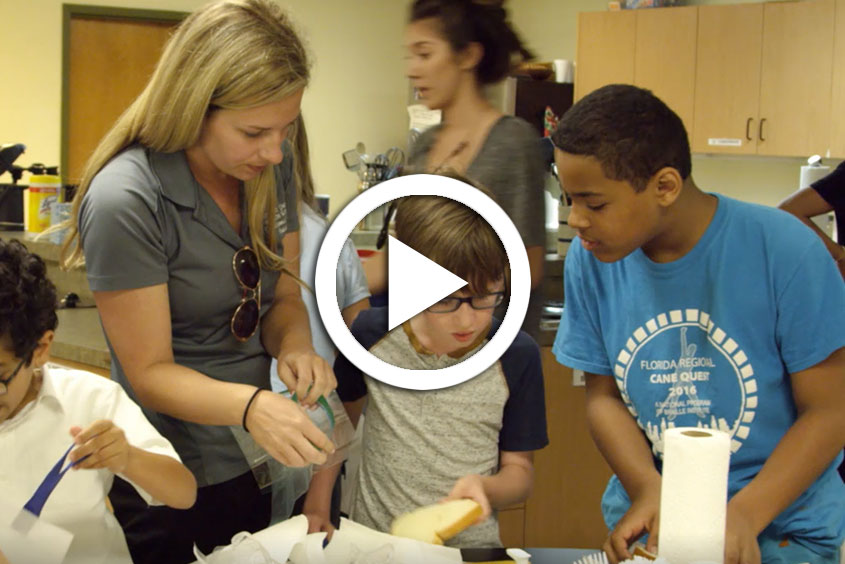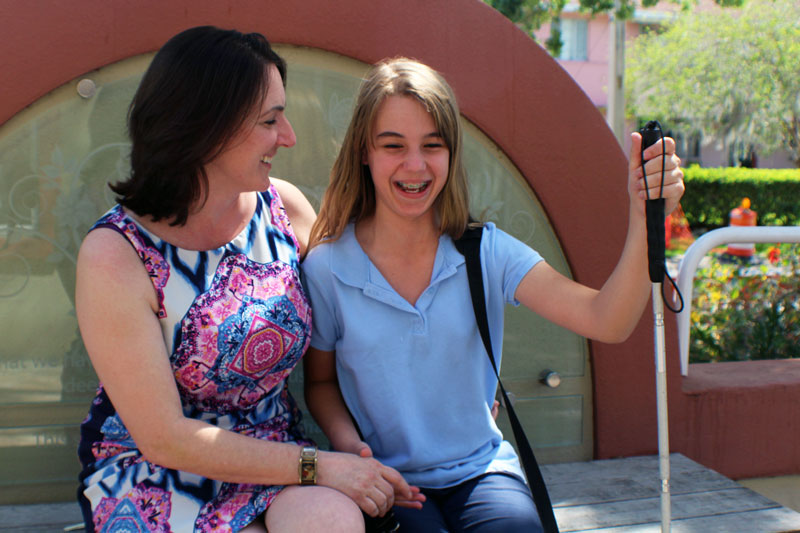CHILDREN'S PROGRAM
"Working with kids between the ages of 5-13, our Children's Program focuses on areas of life that really aren’t addressed by academics alone."

How the Children's Program Helps Your Child
Lighthouse Central Florida’s Children's Program is a supplement to services already offered by the school system for students age 5 (five) through 13 (thirteen), who live with vision loss and are not currently enrolled in any other Division of Blind Services program.These services enhance each child’s learning and ability to function independently, and engage the child’s parents, guardians, and family members as integral members who can help foster independence. The Children’s Program supports the Expanded Core Curriculum and encourages socialization and independent living skills across nine areas of instruction:
- Compensatory Skills: will help the student who is blind learn about the world, communicate, and develop literacy. Compensatory skills include concept development, spatial understanding, study and organizational skills, speaking and listening skills and the adaptations required to fully access all areas of the general curriculum.
- Sensory Efficiency Skills: includes instruction in the use of residual vision, hearing and other senses including use of tactual, gustatory, and olfactory input to identify one's personal possessions, or use hearing and other senses to identify people.
- Assistive Technology: adaptive devices or services that increases participation, achievement or independence for a student with a disability. Assistive technology helps students who are visually impaired (with and without additional disabilities) increase their access to the general curriculum and improve their academic performance.
- Orientation & Mobility: focuses on using alternatives to using sight for safe and independent travel purposes. Student will be taught trailing techniques, search patterns, sighted guide techniques, use of vision for travel and orientation, use of the long cane, and independent travel in a variety of environments.
- Independent Living Skills: it is important for students to develop responsibility and independence in order to become the most independent and contributing members of their homes and communities — which in turn promotes social acceptance. Independent Living Skills include tasks such as cooking, cleaning, personal hygiene, picking out matching clothes, identifying correct denominations of currency, and much more.
- Social Skills: instruction in knowledge of self, knowledge of their visual impairment, knowledge of others, development of interaction skills, development of social skills, introducing the student to lifelong recreation and leisure skills and self advocacy skills. Success in this area often means the difference between social isolation and a satisfying and fulfilling life as an adult.
- Recreation & Leisure: as with social interaction skills, visually impaired students need help identifying the array of choices available to them in this area and must be taught how to perform leisure skills that most students learn through observation. Each person will have their own interests and preferences, but it is important to help a student discover a lifelong leisure activity. Examples of activities include arts/crafts, reading, culture, fitness, outdoor & community activities.
- Career Education: for students with visual impairments, career education needs to begin as early as possible and include self-awareness & career exploration activities, job seeking skills instruction, information about job keeping, and encourage opportunities for gaining work experience. Students who are blind or visually impaired should have the opportunity to explore a wide range of careers in a systematic, well-planned manner as they will not be able to casually observe these jobs as their sighted peers can.
- Self Determination & Advocacy: students need to understand their visual impairment in order to effectively communicate and advocate for their needs. It is equally important for students to learn how to problem solve in order to make necessary adaptations in order to be successful.

Addies's Story
Addison was born with Peter’s Anomaly. This is an eye condition that occurs in an area at the front part of the eye known as the anterior segment. The anterior is where the lens, iris and cornea are located. During development of the eye, the elements of the anterior segment form separate structures.Except for this eye condition, Addison is an otherwise healthy girl. The initial reaction from her parents was a mix of powerful emotions: shock, sadness, confusion. The doctors who initially treated Addison believed there was little more they could do for her and did not refer the family to any local organizations that could help. Addison’s family first learned of the services provided by Lighthouse through an eye clinic in South Florida. They enrolled her in the Early Intervention program when Addison was six months old.
Now, 11 years later, Addie has developed into a pretty amazing girl—according to her mom. “She is outgoing and has the most positive ‘can do!’ attitude.”
Children’s services are provided through afterschool and weekend programs that support the Expanded Core Curriculum and encourages socialization and independent living skills across varying environments.
These services enhance each child’s learning and ability to function independently. The children's parents, guardians, and family members are engaged as integral members who can help foster independence.

Not being able to observe physical gestures or facial expressions makes it difficult to understand social nuances. Students learn essential social skills in order to prepare them for success.

